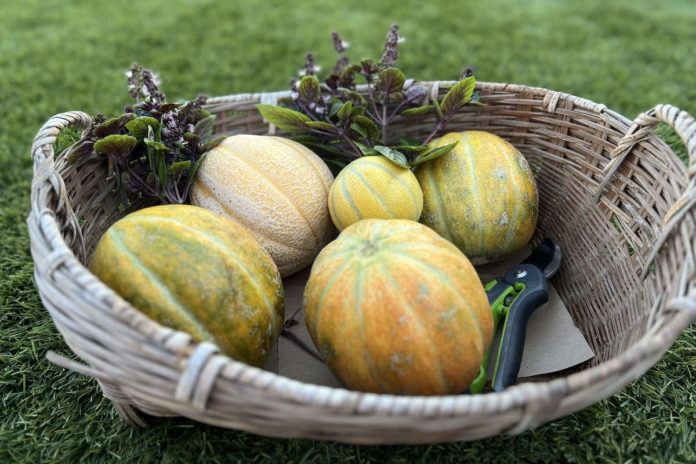Cucumbers and cantaloupes belong to the same family known as Cucurbitaceae, and the members of this family are called cucurbits. They are annual plants with tender tendrils, growing trailing and climbing vigorous vines and producing delicious fruit. Cucumbers and cantaloupes are among my favorite cucurbits for a summer harvest. I typically start the seeds indoors about three weeks prior to the planting time, which for me is late April to early May. I find that cucurbits germinate easily, and this allows me to try out many varieties. They can be planted outside once the temperatures are consistently above mid-seventies. Sow two to three seeds per pot in moist soil and keep it in a warm place. Once the seeds have germinated, move them to a sunny location. If sowing directly in the ground, follow the directions on the seed packet for timing and depth. Some newer hybrid varieties are resistant to many common plant diseases, and seeds are easy to find, especially from online retailers.
So far, my favorite varieties of cucumbers are Dragon Suhyo Hybrid and Natsu Fushinari. They both have performed well in terms of yield, were not bitter and showed resistance to powdery mildew. Bitterness can be an issue with cucumbers. Excessive heat, dry conditions, or poor soil can cause the fruit to be bitter due to the higher concentration of a compound called cucurbitacin. Look for varieties with thinner skins, or ones labeled as “bitter free” to address this. Sometimes they are also labeled as “burpless.”
The cantaloupe variety that I have really enjoyed growing is Emerald Gem, an early-ripening variety and a prolific producer. The ripe fruit has a lot of bite to it, is juicy, and coats the palate with many floral notes. When ripe, it is aromatic and will slip from the vine when pulled gently. If the cantaloupe is not fully ripe when harvested, I leave it at room temperature away from sunlight for a couple of days and it ripens just fine, although the sweetness does not improve. One cantaloupe I am looking forward to growing is the Ambrosia Hybrid, as it is a disease resistant variety.
Cucurbits have surprised me with volunteer plants. This year, I had a volunteer melon growing which turned out to be the hami melon. It probably grew out of a seed brought to my yard by a bird or a breeze! It is oblong in shape, has less prominent netting and is much heavier than a lot of other melons. It is firm in texture, has a cucumber-like fragrance and crunch and turns yellow as it ripens. Unripe hami cantaloupes are hard to thumb pressure but have a give when ripe. The rind is thicker and the inside color is “lemony.”
Due to their sprawling nature, cucurbits need more space per plant than some other summertime plants like peppers or eggplant. If space is a concern, choose bush type varieties for your garden. Container or compact varieties of cucumbers produce smaller fruit, but still in a decent number. Cantaloupe varieties suitable for container growing are also available, but their yield varies depending on factors like container size, soil quality, nutrition etc. The summers I have grown cantaloupe, I have had to pass on growing some other plants as they take up a lot of space.
Both cucumbers and cantaloupe like water. Cucumbers like frequent and consistent watering but not waterlogging. A soaker hose or drip irrigation works well. Although cantaloupes prefer infrequent deep watering, recent heat waves have dictated some schedule modifications. I have had to water them every day to prevent vines from wilting and leaves from crisping up to the point of no return. In the midst of all this, one must make sure that these conditions do not encourage high humidity as it can invite fungal diseases. Vines also like fertilizer feedings during the growing season, especially once they have put on fruit. An application of a granular or water-soluble fertilizer intended for the crop is very helpful.
For the longest time allowed cucurbits to spread on the ground. The size of the fruit and its pendulous nature, especially for cantaloupe, did not generate any confidence in them being able to trellis upward. But they can. To secure higher-hanging fruit, I cover them with a mesh bag, making sure to tie the drawstring to the trellis structure, not just the fruit. Since cucumber matures into fruit within a few days, I leave them as is. Growing vertically is a space saver but can sometimes cause sun scalding on the fruit, so watch out for that. I also plant cucumbers in succession about five to six weeks apart. This allows me to try out more than one variety during the same growing season. Having a seedling on standby is helpful too if I lose the first plant to unexpected frost, disease or a pest.
A meal on its own, cantaloupes can be enjoyed fresh, frozen, as sorbets, and in salads to mention a few ways. They also look stunning in fresh fruit bouquets when carved out in different shapes and can dress up cocktails and beverages as scooped out melon balls. Cucumbers can be added to salads, sandwiches, made into pickles or can be paired with hummus for refreshing summertime snacks and meals.
Note: This article gives an overview of growing plants, sun and soil requirements, moisture needs etc. Plant health and growth will vary based on various factors. This article is intended for gardening and culinary inspiration only. Please consult your healthcare provider should you have any questions or concerns about adding any new foods or ingredients to your diet.




